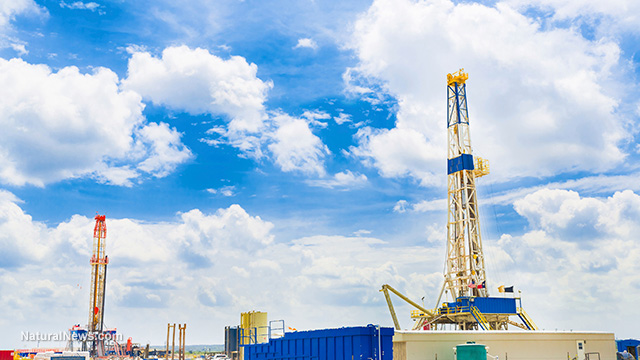Toxic fracking chemicals persist in the environment, polluting food and water while damaging public health
Sunday, June 26, 2016 by: Isabelle Z.
Tags: fracking, pollution, environment

(NaturalNews) Another study has emerged showing just how enduring the negative impact caused by fracking on the environment actually is. The disturbing results show that toxic fracking chemicals remain in the environment for a very long time, compromising people's food and water for many years to come.
In the process of fracking, a mixture of water and chemicals is injected into the ground while drilling into formations of shale and rock to extract oil. The chemicals involved might be surfactants, corrosion inhibitors, toxic biocides, or slicking agents.
A group of researchers from Colorado State University (CSU) recently carried out a study to uncover where these chemicals end up after being accidentally spilled in the process of being transported to fracking sites or during gas and oil operations. The scientists are particularly concerned because many of these spills occur on agricultural lands or in their vicinity, where they can make their way into the food and water supply.
The researchers simulated spills with a reactor and studied the various chemical reactions involved as well as the breakdown of three of the fracking chemicals: the biocide that impedes pipe corrosion known as glutaraldehyde, the common surfactant polyethylene glycol (PEG), and the slicking agent polyacrylamide, which is used to help fracking fluid penetrate shale. The researchers eventually plan to test out these conclusions at real spill sites.
They looked at 838 hydraulic fracturing fluid spills in the state of Colorado during the year 2014, all of which entailed more than five barrels of fluid for well pad spills and more than one barrel for non-well pad spills. Their findings were published in the Environmental Science and Technology journal.
Combinations of chemicals can affect breakdown time
The researchers discovered that certain chemical combinations resulted in a slower breakdown. On its own, the PEG biodegrades completely in about 70 days, but it sticks around much longer when combined with glutaraldehyde. Even worse, a combination involving glutaraldehyde and the commonly used polyethylene glycol (PEG) did not break down at all in the presence of typical salt concentrations. The team is calling for further research to uncover various reactions between spilled chemicals and the environment.Professor Thomas Borch of the College of Agricultural Sciences' Department of Soil and Crop Sciences, who was part of the team, stated: "Our motivation for doing this is because the chemicals often come up as mixtures. While you may see biodegradation of a surfactant under normal circumstances, if you spill that together with a biocide that kills bacteria, maybe you don't break that surfactant down as quickly. And that's exactly what we see. If chemicals don't degrade as quickly, it gives them more time to be transported to groundwater or sensitive surface water."
Millions of gallons of toxic wastewater dumped
A recent peer-reviewed study published in the same journal, Environmental Science and Technology, showed how thousands of fracking wastewater spills in North Dakota left rivers and streams heavily contaminated with radioactive materials, corrosive salts, and heavy metals.Estimates show that more than 21,000 spills occurred during the years from 2009 to 2014, and the amount of toxic wastewater dumped in these incidents exceeds 180 million gallons! That's not even taking into account the spills that don't get reported, such as those that occur on tribal lands.
The spills can be partly attributed to the lack of monitoring by local and federal authorities as well as lax and outdated regulations.
In this study, one particular site that was examined still showed elevated concentrations of a number of different toxic substances four years after the spill took place. The sites that are contaminated with radium will be radioactive for thousands of years, according to the researchers.
People who live near fracking sites can send samples of their water to EPAWatch.org for free testing to find out how their water has been affected by this harmful practice.
If fracking practices continue unabated at their current pace, the widespread water and food pollution caused could become a significant public health issue.
Sources include:
http://www.coloradoan.com
http://pubs.acs.org/doi/abs/10.1021/acs.est.6b00240
http://source.colostate.edu
http://epawatch.org
http://science.naturalnews.com/Polyethylene_glycol.html
Fracking at FETCH.news
Get independent news alerts on natural cures, food lab tests, cannabis medicine, science, robotics, drones, privacy and more.
Take Action: Support Natural News by linking to this article from your website
Permalink to this article:
Embed article link: (copy HTML code below):
Reprinting this article:
Non-commercial use OK, cite NaturalNews.com with clickable link.
Follow Natural News on Facebook, Twitter, Google Plus, and Pinterest
- Newly released JFK files reveal Pentagon's role in creating Lyme disease and covid in the same lab
- Here are TEN all-natural ways to protect your garden without using harmful chemicals
- Ginseng's hidden anti-aging power: How compound K is rewriting the rules of skincare
- “Endgame: The Hidden Agenda 21” unveils a world of conspiracy and control
- L.A.'s rebuilding nightmare: Only 4 permits issued after fire destroys 6,000 homes
- Scientists demand FDA withdraw mRNA COVID vaccines amid contamination and gene therapy concerns
- Senate Democrats deny censorship industrial complex existed, defend government's role in silencing dissent
- Dr. Suzanne Humphries makes bombshell appearance on Joe Rogan podcast, exposing vaccine industry deception back to POLIOMYELITIS
- “The shame of Minnesota”: Somali immigrants behind $250 million child nutrition fraud in largest COVID-era scam
- Former Congresswoman exposes CCP's deep infiltration of California through universities, ports, and fentanyl
- PROCESSED TABLE SALT in foods found to fuel depression
- Despite surge in MMR vaccination in Texas, measles outbreaks continue: Is VACCINE SHEDDING fueling the spread?
- Chewing gum's dirty secret: How your daily habit could be flooding your body with microplastics
- “Independent” anti-Russia outlet MEDUZA faces COLLAPSE as US funding dries up
- BPA: The hidden hormone disruptor sabotaging your health - and how to fight back
- Embracing the wild: A deep dive into Jim Cobb’s “Backwoods Survival Guide”
- The hidden battle in your glass: How A1 and A2 milk could shape your health
- Catastrophic 7.7 earthquake devastates Myanmar and Thailand; death toll could reach 100,000
- Newly released JFK files reveal Pentagon's role in creating Lyme disease and covid in the same lab
- Analysis: The coming economic collapse, a mass uprising and Trump's three secret weapons to halt the growing revolt
- Festive flavors: The sweet history, nutritional profile and health benefits of pecan pie
- Elon Musk: Aliens could be here on Earth RIGHT NOW
- Trump reverses course on Gaza plan, says “nobody is expelling Palestinians”
- Big Pharma's $8 Billion bribery scheme exposed: how doctors are pushed to prescribe junk science, not heal
- Boys are back in town: Trump’s patriotic alpha crew takes the wheel while toxic females ride in the backseat
- Reclaim your health: How midlife exercise reverses years of inactivity
- A lack of integrity in Academia: Harvard professor found GUILTY of fraudulent research to promote CRT theory
- Survival 101: Effective EMF blocking techniques
- EPA advisor admits the agency is funneling billions to climate groups ahead of Trump’s return to White House
- Dr. Mike Yeadon releases 15-minute testimony - WATCH - about genocidal intent of COVID “vaccines”
- 5 Simple steps to boost your brainpower: How to strengthen executive function in a distracted world
- Florida takes a stand: DeSantis proposes permanent ban on mRNA vaccine mandates
- Sugarcane extract superior to cholesterol-lowering drugs?
- Mike Adams Sermon 66: God will DESTROY ISRAEL for its wickedness
- Pilots report mysterious lights 'moving at extreme speeds' across Oregon skies
- Space war brewing? Russia threatens to destroy Starlink satellites
- EPA advisor admits the agency is funneling billions to climate groups ahead of Trump’s return to White House
- California's social media censorship law struck down: A victory for free speech or a threat to online safety?
- The Health Ranger releases “Vaccine Zombie” song and music video, using AI-animated zombies for the music video
- Dr. Mike Yeadon releases 15-minute testimony - WATCH - about genocidal intent of COVID “vaccines”
- The pandemic as a tool for INDOCTRINATION: Understanding “The Indoctrinated Brain” by Dr. Michael Nehls
- Newly released JFK files reveal Pentagon's role in creating Lyme disease and covid in the same lab
- Florida takes a stand: DeSantis proposes permanent ban on mRNA vaccine mandates
- Mike Adams releases country western hit single: Goin’ Back in Time is Comin’ Home
- Mike Adams releases music poetry sensation: A Child of God
- “Why we influenced the 2020 elections”: Facebook files reveal the coordinated effort to bury the Hunter Biden laptop story
- Unpacking the Lies That We’ve Been Fed – new song and music video released by Mike Adams, the Health Ranger
- RFK Jr. clears key hurdle: Sen. Susan Collins backs controversial HHS nominee, signaling a new era for health policy
- Mike Adams releases new song and music video: Nothing More Disgusting Than a Globalist
- Michigan sheriff announces criminal investigation into 2020 election crimes, Dominion Voting Systems
- Israeli soldiers accused of even more torture and abuse in the West Bank
- Migrants are taking advantage of recent hurricanes to scam residents and loot their homes
- House Intelligence Committee calls for the ARREST and PROSECUTION of Dr. Anthony Fauci
- Rep. Nancy Mace introduces bill to ban biological males from female facilities on federal property
- Red Cross issues warning to stop blood plasma donations from vaccinated people
- Scientists confirm: GENIUS brain function can be spontaneously unleashed in humans without any apparent cause
- EPA advisor admits the agency is funneling billions to climate groups ahead of Trump’s return to White House
- HYSSOP: What research reveals about the health benefits of this ancient holy herb
- Two containers with completed ballots fall out of truck in Florida
- Fully vaccinated about to see “tsunami” of illness and death, warns virologist
- Global leaders unite to clamp down on “misinformation” with UN-backed Cascais Declaration
- BREAKING: 2025 NDAA authorizes mandatory military draft of WOMEN across America… as Pentagon pursues global NUCLEAR war with both Russia and China at the same time
- Michael Yon warns of a ZIONIST TAKEOVER in Trump’s second administration
- BOMBSHELL: DNA testing kits are a SCAM to develop ethnic-specific bioweapons
- Ozempic and Wegovy weight loss drugs are injectable LIZARD VENOM PEPTIDES that may unleash a devastating wave of organ failure… side effects align with symptoms of SNAKE BITES
- Israeli soldiers accused of even more torture and abuse in the West Bank
- These 13 countries just signed an agreement to engineer a global FAMINE by destroying food supply
- NASA admits that climate change occurs because of changes in Earth’s solar orbit, and NOT because of SUVs and fossil fuels
- RFK Jr. clears key hurdle: Sen. Susan Collins backs controversial HHS nominee, signaling a new era for health policy
- Sermon 30: How Jesus reveals Caesar’s FAKE CURRENCY and FALSE AUTHORITY
- Coriander seeds: Ancient medicine backed by modern science
- Arizona officials claim Maricopa County needs 10-13 days to tabulate results of the election
Science News & Studies
Medicine News and Information
Food News & Studies
Health News & Studies
Herbs News & Information
Pollution News & Studies
Cancer News & Studies
Climate News & Studies
Survival News & Information
Gear News & Information
News covering technology, stocks, hackers, and more



"Big Tech and mainstream media are constantly trying to silence the independent voices that dare to bring you the truth about toxic food ingredients, dangerous medications and the failed, fraudulent science of the profit-driven medical establishment.
Email is one of the best ways to make sure you stay informed, without the censorship of the tech giants (Google, Apple, Facebook, Twitter, YouTube, etc.). Stay informed and you'll even likely learn information that may help save your own life."
–The Health Ranger, Mike Adams












































